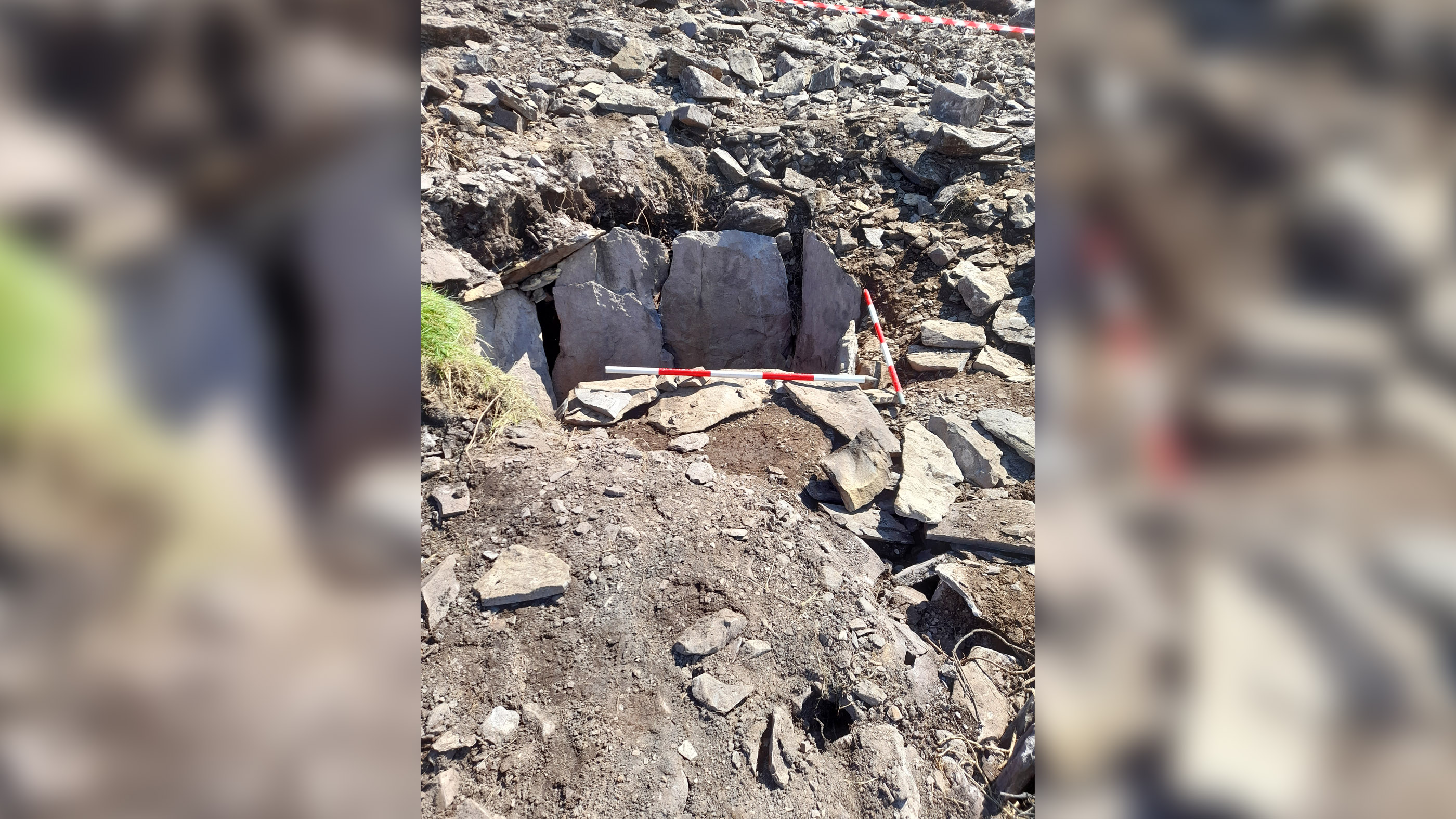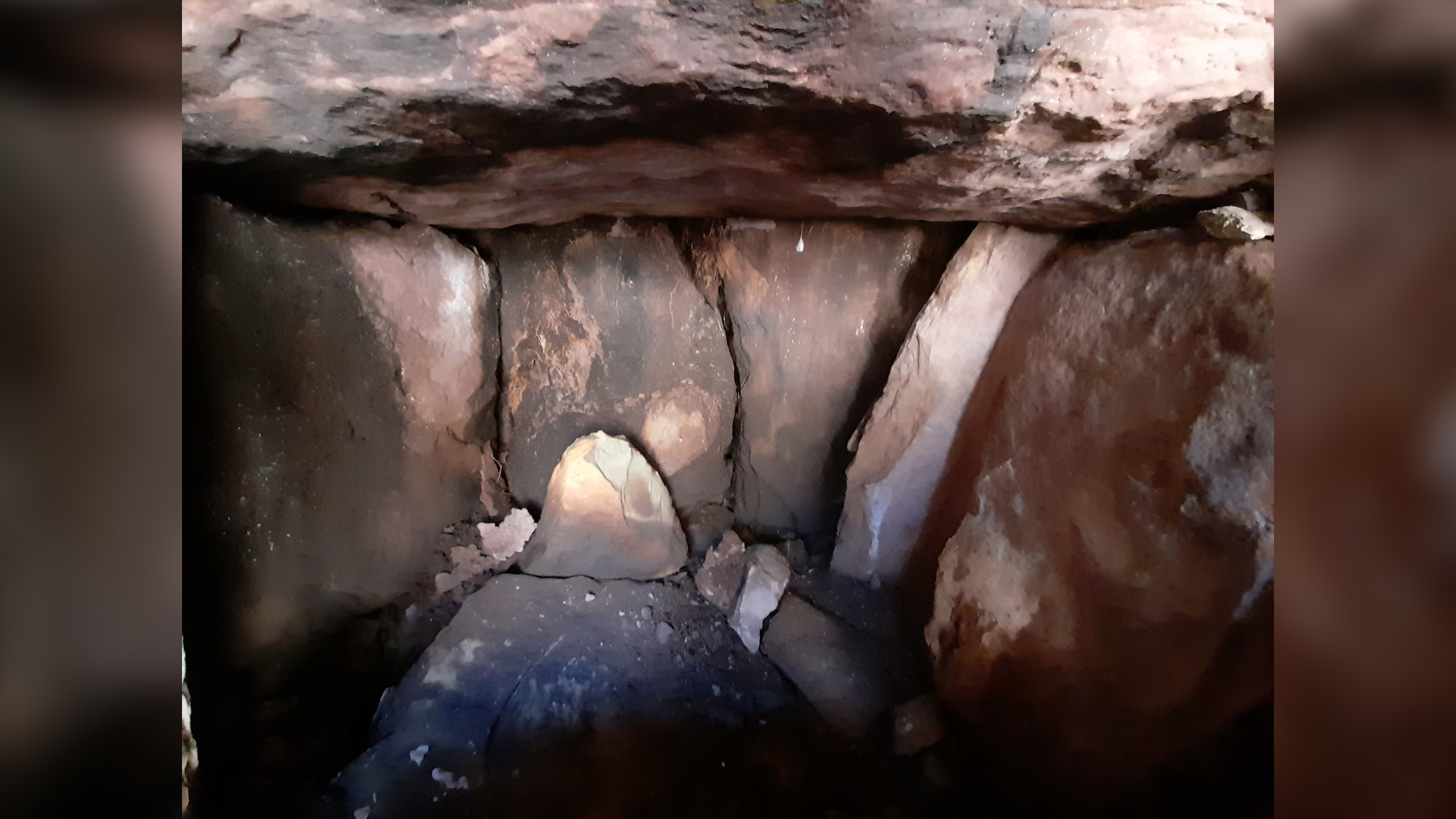'Untouched' Bronze Age tomb containing human remains and a mysterious stone found in Ireland
Discovered by workmen on a farm.

An ancient tomb thought to date back more than 3,000 years has been discovered in southwest Ireland by workmen carrying out land improvements on a farm.
Archaeologists say the tomb on the Dingle Peninsula of County Kerry is "untouched" and that some of its unusual features, including a mysterious oval-shaped stone inside, indicate that it could be an early example of an ancient burial.
The tomb appears to be a "cist" or chamber tomb, consisting of an underground stone-lined structure built to contain one or several burials and capped with a large stone, Ronan Casey, a spokesperson for Ireland's National Monuments Service, told Live Science.
Related: The 25 most mysterious archaeological finds on Earth
"Such burials would typically date to the Bronze Age, commencing around 2500 B.C.," Casey said in an email.
Ireland's national broadcaster RTE reported that the tomb was discovered last week when a mechanical digger overturned the large stone slab above it, revealing the chamber beneath. A closer inspection revealed an adjoining sub-chamber at what appears to be the front of the tomb.
"The discovery was reported to the National Monuments Service and National Museum of Ireland very promptly, for which we are very grateful," Casey said. But the exact location of the find is not being publicized to protect the tomb from the possibility of disturbance or looting.
Sign up for the Live Science daily newsletter now
Get the world’s most fascinating discoveries delivered straight to your inbox.

Bronze Age burial
Archaeologists estimate the tomb dates to between about 2,500 and 4,500 years ago, during the Bronze Age in Ireland. But further investigations will be needed before they can narrow down its age, Casey said..
"While we suspect that the cist burial may date to the Bronze Age, we do not yet have conclusive evidence of its date," he said. "At this stage, so early into the discovery and site works, we don't have the full picture yet."
Experts from the National Monuments Service and Ireland's National Museum have inspected the site and recovered "ancient skeletal remains" from the tomb.
Related: Photos: gold, amber and bronze treasures found in Iron Age grave
They sent a sample of the remains to a laboratory for radiocarbon analysis, which could potentially give a more accurate range of dates for the burial, Casey said, although that process will take several weeks.
One of the most unusual finds in the ancient tomb is a polished stone with a roughly oval shape. Its purpose is unknown, but it was interred beside the human remains; the archaeologists removed it for safekeeping.
Ancient Irish tombs
The region has numerous megalithic tombs known to date from the Bronze Age. "Such graves from this period are not uncommon, and there are numerous sites and monuments from this period on the Dingle Peninsula," Casey said.
But this new discovery stands out. Only the central part of it has been unearthed so far, so the exact layout of the structure remains uncertain. But what's been seen so far seems different from other ancient tombs in the same area.
"Given its location, orientation and the existence of the large slab your initial thought is this is a Bronze Age tomb," local archaeologist Mícheál Ó Coileáin told RTE. "But the design of this particular tomb is not like any of the other Bronze Age burial sites we have here."
One feature that could help determine its age is how it is oriented, archaeologist Breandán Ó Cíobháin told RTE.
"In the south-west of Ireland we have a significant number of wedge tombs, in Cork and Kerry in particular," he said. "The majority are generally orientated to the west and south-west. It is not clear why, but it may represent celestial or lunar alignments … but as much of this particular tomb remains hidden underground it is difficult to fully assess the layout."
Ireland has thousands of ancient monuments and tombs. The most famous is the passage tomb at Newgrange, beside the River Boyne about 25 miles (40 kilometers) north of Dublin, which is aligned so that the rising midwinter sun shines down its internal passage and illuminates a chamber deep within.
Related: In photos: Ireland's Newgrange passage tomb and henge
Recent research found that one of the Bronze Age people buried inside the Newgrange tomb was the son of parents who were probably brother and sister — a practice not uncommon in ancient royalty.
Newgrange is just one of many tombs in the area known as the Brú na Bóinne Neolithic cemetery, which is listed as a World Heritage site by UNESCO, and the entire country is dotted with ancient megalithic structures.
Some of them date from more than 5,000 years ago, making them older than both Stonehenge in England and the oldest pyramids in Egypt.
Originally published on Live Science.
Tom Metcalfe is a freelance journalist and regular Live Science contributor who is based in London in the United Kingdom. Tom writes mainly about science, space, archaeology, the Earth and the oceans. He has also written for the BBC, NBC News, National Geographic, Scientific American, Air & Space, and many others.









